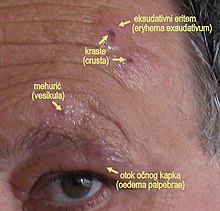| Herpes zoster ophthalmicus | |
|---|---|
| Other names | Ophthalmic zoster |
 | |
| Herpes zoster ophthalmicus | |
| Specialty | Ophthalmology |
| Symptoms | Rash of the forehead, swelling of the eyelid, pain and red eye |
| Complications | visual impairment, increased pressure within the eye, chronic pain, stroke |
| Causes | Reactivation of varicella zoster virus |
| Risk factors | Poor immune function, psychological stress, older age |
| Diagnostic method | Based on symptoms |
| Prevention | Herpes zoster vaccine |
| Medication | Antiviral pills such as acyclovir, steroid eye drops |
| Frequency | Up to 125,000 per year (US)[1] |
Herpes zoster ophthalmicus (HZO), also known as ophthalmic zoster, is shingles involving the eye or the surrounding area. Common signs include a rash of the forehead with swelling of the eyelid. There may also be eye pain and redness, inflammation of the conjunctiva, cornea or uvea, and sensitivity to light. Fever and tingling of the skin and allodynia near the eye may precede the rash. Complications may include visual impairment, increased pressure within the eye, chronic pain,[1][2][3] and stroke.[4]
The underlying mechanism involves a reactivation of the latent varicella zoster virus (VZV) within the trigeminal ganglion supplying the ophthalmic nerve (the first division of the trigeminal nerve). Diagnosis is generally based on signs and symptoms.[2] Alternatively, fluid collected from the rash may be analyzed for VZV DNA using real-time PCR. This test is rapid, easy to perform, and is highly sensitive and specific method for diagnosing this condition.[5]
Treatment is generally with antiviral pills such as acyclovir. Steroid eye drops and drops to dilate the pupil may also be used. The herpes zoster vaccine is recommended for prevention in those over the age of 50.[2] HZO is the second most common manifestation of shingles, the first being involvement of skin of the thorax.[citation needed] Shingles affects up to one half million people in the United States per year, of which 10% to 25% is HZO.[1][3]
- ^ a b c "Herpetic Corneal Infections: Herpes Zoster Ophthalmicus". www.aao.org. Archived from the original on 15 August 2020. Retrieved 21 December 2019.
- ^ a b c "Herpes Zoster Ophthalmicus - Eye Disorders". Merck Manuals Professional Edition. Archived from the original on 12 August 2016. Retrieved 21 December 2019.
- ^ a b Shaikh S, Ta CN (November 2002). "Evaluation and management of herpes zoster ophthalmicus". American Family Physician. 66 (9): 1723–30. PMID 12449270.
- ^ Nagel MA, Gilden D (April 2015). "The relationship between herpes zoster and stroke". Current Neurology and Neuroscience Reports. 15 (4): 16. doi:10.1007/s11910-015-0534-4. PMC 5489066. PMID 25712420.
- ^ Beards G, Graham C, Pillay D (1998). "Investigation of vesicular rashes for HSV and VZV by PCR". J. Med. Virol. 54 (3): 155–7. doi:10.1002/(SICI)1096-9071(199803)54:3<155::AID-JMV1>3.0.CO;2-4. PMID 9515761. S2CID 24215093.